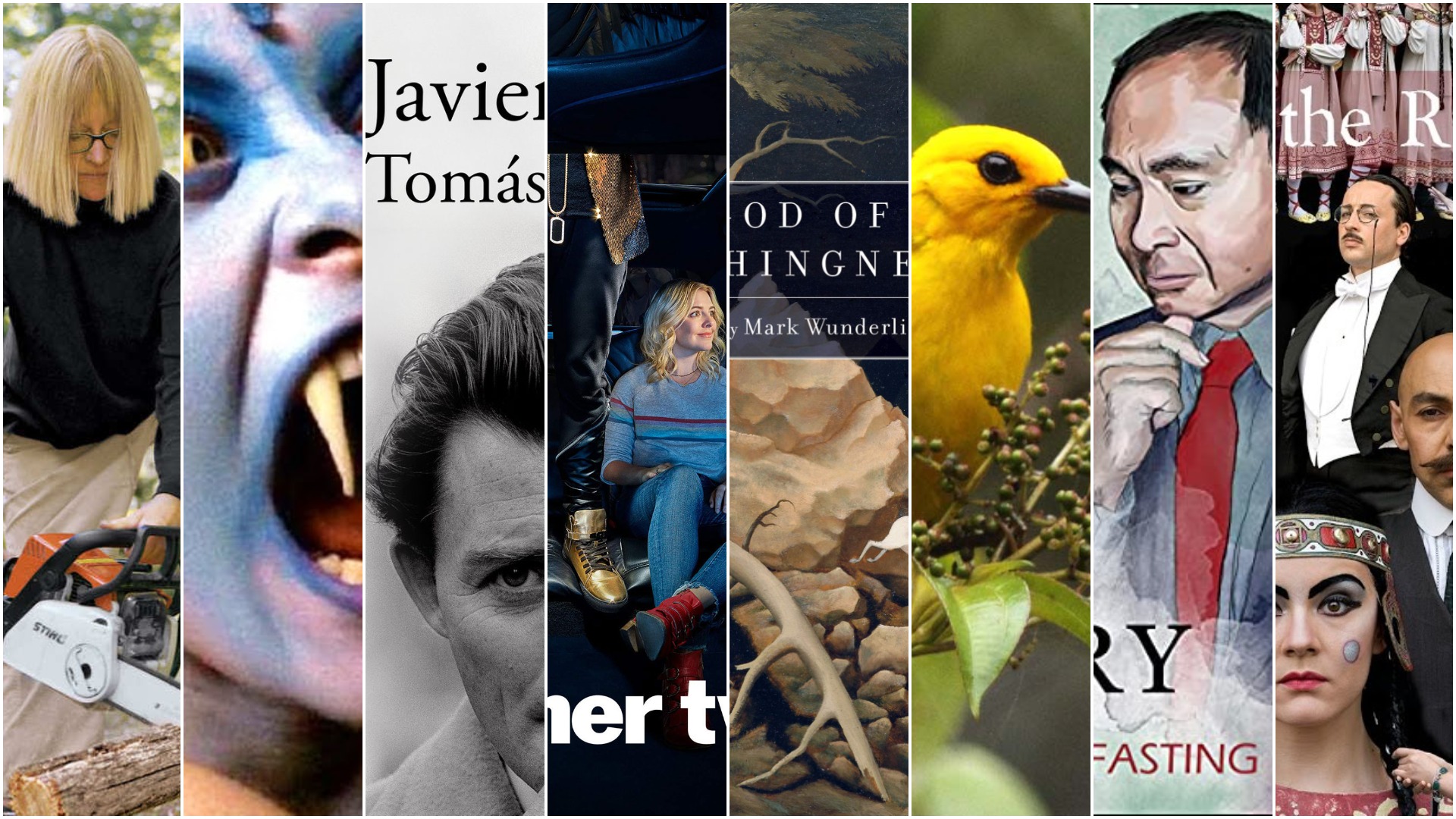
Mentions | Issue 5
After The End of History |
INTERVIEWS
This new book of interviews with Francis Fukuyama offers CliffsNotes summaries that will be useful to any budding dinner party Grand Strategist. The funniest reveal comes when Fukuyama admits that, before he began dabbling in geopolitical “realism,” he aspired to a career in comparative literature. Among his recollections: a weekend of cruising and partying with Foucault, Julia Kristeva explaining to him “that there was a point to Stalinism,” and his own brief flirtation with “imitating Nietzsche” before he turned to more “down-to-earth” interests like the supremacy of liberal democracy. It makes a strange sort of sense that the man who filled a widespread need for a narrative to replace the Cold War once sharpened his tools on the cutting edge of narrative theory.
A.L.
The Riot at the Rite |
FILM
Russian wunderkind Vaslav Nijinsky’s 1913 ballet The Rite of Spring was the first of its kind: a deliberate rejection of classical form — in favor of jerky, recursive movement, like folk dance on Adderall — set to a clangorous score from Igor Stravinsky. The BBC’s 2005 historical drama about the ballet’s Paris premiere is mostly froth, reducing Nijinsky, Stravinsky, and troupe director Sergei Diaghilev to a trio of imperious dandies. In this rendering, Nijinsky falls in love not with Diaghilev, his longtime partner in real life, but with a woman, and the dialogue demonstrates a SparkNotes-level understanding of modernism. “It will be new, and it will be beautiful,” Nijinsky intones, sounding like an Ezra Pound wind-up doll.
S.K.
Sleepcasts |
APP
Produced by the mindfulness app Headspace, these recordings promise to knock you out with a series of relaxing stories, pleasant ambient sounds, and a “wind-down exercise” (a mini-meditation perhaps tacked on for brand consistency). In some casts, listeners are transported to an idyllic natural setting: you’re floating down a river, hiking in a lush forest, staring at a night sky sans light pollution. For the urban apartment claustrophobe, these tend to work well. In other casts, hopeful sleepers visit small businesses and unwind as employees stock artisan soaps or tend to antique furniture, peddling a vision of labor entirely rid of the indignities of the waking world. Presumably, neither genre undergoes rigorous fact-checking, but city-snoozers may question the placid elation of the sleepcasts’ fictional staff. How much is the waitress at the mysterious nocturnal diner in the middle of the desert actually getting paid? Tips, at least, must be difficult to come by.
E.B.
r/BreadStapledtoTrees |
FORUM
The three fundamental rules of this subreddit are, as community guidelines go, forthright: 1. Don’t post non-bread. 2. Don’t post non-stapled bread. 3. Don’t staple it to non-trees. Nevertheless, the group’s nearly 300,000 members often reinterpret the rules to suit their circumstances. A recent post, captioned “double stapled for safety” exploited a loophole — staple quantity was never specified — and was upvoted nearly 2,000 times. One contrarian, who asked, “Can you use nails?” found a less receptive moderator: “Only if moulded into staples and attached the same way.” There are, as rule-enforcers will note, other forums for bread screwed or nailed to trees. But most scorn is reserved for those who question the sub’s purpose altogether. Skeptical queries are met with downvotes and the frequent reply: “Why not?”
M.M.
Art’s Library |
BIBLIOPHILIA
Art Garfunkel’s personal website includes a series of pages cataloging every book he has read since 1968. In 2018, alongside titles from Madeleine Albright, J. Edgar Hoover, Gabriel García Márquez, Ruth Bader Ginsburg, Ayn Rand, Naomi Klein, and Marianne Williamson, he lists the latest biography of Paul Simon, but the book did not make his “favorites” section.
R.D.A.
The Lair of the White Worm |
FILM
In this 1988 Ken Russell flick, a subterranean snake-god in Derbyshire commandeers the bodies of immortal lords and ladies to cajole, bite, and sacrifice innocents. An adaptation of the Bram Stoker horror novel by the same name, the movie is a biblically carnal affair, mixing Russell’s taste for blasphemy with a more Gothic-era homoeroticism: picture a fat white snake throttling Jesus on the cross. Ideal viewing for horny atheists who want to see Brits in leather thigh-highs and pearly fangs.
S.M.
Mr. Mucus |
PHARMACEUTICALS
Mucinex’s decade-spanning marketing campaign for its over-the-counter cold medicine stars a plump booger who talks like Joe Pesci. In every commercial, he wears a stained undershirt, takes shelter in human lungs, and, in the climax, gets booted from his home by a landlord in the shape of a juicy, Mucinex-assisted cough. It’s an animation blending eviction, respiratory infections, the specter of a decrepit New York. Movies increasingly feel indistinguishable from TV commercials, but ad agencies have always been good at making special, stupid fables out of real life.
M.T.
Helen DeWitt’s posts |
ONLINE
The self-professed author of nearly a hundred novels, just two of which made it to print (a third was briefly sold as a PDF on her website), Helen DeWitt also tweets and blogs on Goodreads, casually but earnestly, about specific and mundane parts of her life. “Oh no, someone is awake,” reads one entry. In others, she has expanded on family anecdotes, used furniture, and stray thoughts: “n.b. I have never thought I missed out on [an] alternative career as personal trainer.” DeWitt once mentioned joining “a loose group of people in Windham County (VT) who turn up at each other’s houses to cut/slip/stack firewood.”As with her fiction, which often demands a bit of decoding, full immersion is the key to comprehension. Read just the first tweet in a thread that mentions a “weekend workshop on lockpicking” and risk missing a hierarchy of locks (ranked by complexity), a link to a two-day “Women’s Game of Logging” intensive on chainsaws, and musings on a course that would combine it all. “There cd be intensive language workshops,” she concludes, “(read 10 lines of Iliad after 2 hrs, etc.).”
T.B.
Ghosted: Love Gone Missing |
ROMANCE
In this MTV reality show, Bachelor alum Rachel Lindsay and ex-rapper Travis Mills (fka “T. Mills”) help the “haunted” (read: dumped people) find their “ghosts” (exes). The series frames the phenomenon of “ghosting” as a product of modern pessimism; its somewhat cruel solution is unadulterated optimism, realized through a plot device the hosts call “The Confrontation.” One participant, forced to face her ex over Zoom, hangs up on him when he deflects blame for the break-up. (He cheated.) “All we want is… to give our haunted some closure,” T. Mills muses, “and I think she definitely got that today.”
S.G.
God of Nothingness |
POETRY
The poems in Mark Wunderlich’s previous book, The Earth Avails, depicted a pastoral life that was savage and conflicted, expressed in clipped phrases and urgent consonants: “Meat. Bristled hide that can’t be called skin/never skin — too bristled for that, too dry,” he wrote in “Wild Boar.” But in his latest collection, the poet in crisis seems less troubled. The imagery hasn’t changed (e.g., lots of animals), but Wunderlich’s severe music has given way to something sweeter and more like prose. Here he is, in “Death of a Cat”: “Little beast on the metal table, she took/the needle into her forepaw // and didn’t flinch.” Long sentences, stitched together with soft conjunctions and gentle commas, show a poet impressed less by the coarseness of existence than by the intimacy of its end. “The medicinal death/fit itself inside her, ran the blue and red map,” he writes, “burned up into her lungs and brain, / and heart, which slowed, and she slept until there was no breath left/and her body emptied itself of air.”
J.B.
HEY |
INNOVATION
Launched by Basecamp, this premium email service was designed to fix what’s wrong with email. For only $99/year, you can have an “Imbox” (the “im” stands for “important”), automatically send reply-alls, and spend hours puzzling out who sent what and when, because detangling an email thread requires more close attention than reading the average novel. Gmail may be less than perfect, but at least your address doesn’t end in “@hey.com.”
M.C.
@_everybird_ |
FOWL
A welcome reprieve from the churn of discourse and almost certainly the Twitter account with the most plumage per tweet, this bot’s original aim was to post a picture of every single bird species known to exist. Having already completed that mission, @_everybird_ is now retweeting the original series of birds forever.
E.M.
City of Women |
FILM
In one four-minute interlude in Fellini’s acid trip through second-wave feminism, a carload of women pick up the faded playboy Snàporaz (played by Marcello Mastroianni), who exhibits the slippery charm and entrenched self-loathing of a middling investment banker. Another car approaches, filled with pre-teen girls. Everyone pulls over to smoke, dance, and make faces at each other as Snàporaz looks on, clutching his briefcase. All artifice and moving flesh, the scene could stand alone as an ’80s music video, conveying the timeless message that girls just wanna have fun.
S.K.
The Shelters on Alone |
CONSTRUCTION
The primitive hut, theorized by eighteenth century philosopher Marc-Antoine Laugier as the purest means of shielding man from nature, is the enduring origin myth of architecture. Contestants on the survivalist reality competition Alone — tasked, on a recent season, with spending a hundred days alone in the Canadian Arctic for a million-dollar prize — built several immediately canonical contributions to the hut genre. Highlights include: an Instagrammable A-frame, an elaborate cooktop built from scavenged clay, and a hot tub improvised from a salvaged boat propped over a fire. But the triumphant stone dwelling, “Rock House,” referred to by name like a Victorian estate, stole the show with its laborious construction and attention to heat-retention. For Laugier, the hut represented a return to fundamentals in the face of the ornamental baroque. Alone seems to posit that, despite the drudgery of mere survival, one can aspire to have both.
A.T.
Club Friendly |
MOVEMENT
Six years before “Hands Across America” convinced at least five million citizens to clasp sweaty palms for public service, the actor Charles Grodin asked comedian Carol Burnett to collaborate with him on a national campaign to promote friendliness. Club Friendly, they told the talk show circuit, was a consciousness-raising movement to counter the “meaner society” America had become. If Grodin was to be believed, John Belushi was on board, as were thousands of supportive fans who had seen the duo speak in an upstate New York amphitheater and pledged their fealty in fan letters answered by Grodin’s mother. The campaign, interpreted by many as a conceptual performance, lasted a few weeks at most, but Grodin seemed genuinely wounded that his critics found friendliness “boring.” He mourned the “Friendly” movement in interviews and memoirs until his death in 2021.
M.Mi.
Painting with John |
TV
If most travel shows adhere to a goal-oriented idea of adventure, Fishing with John — John Lurie’s ’90’s short film series in which he took famous friends on fishing trips to remote locations — found its appeal in the opposite. Each outing served as the barest pretext for an extended conversation with no clear direction. Lurie’s new six-part series has a similarly meandering effect, with fishing neatly substituted for painting. In each episode, the 68-year-old renders watercolors from undisclosed Caribbean islands, this time alone. In Painting with John, the main draw is Lurie’s narration, which mixes anecdotes about his decades in New York (snorting coke in a closet with Rick James, dining with Anthony Bourdain just before he died) with asides about his many ailments (cancer, “chronic Lyme”). Lurie recommends painting as a pastime only in the last episode, assuring viewers that it’s good for you. Likely for the same reason, the show was just renewed for a second season.
W.L.
Q: Into the Storm |
TV
This series poses the question: what if one of the world’s worst detectives bumbled across the globe over six episodes trying to trick a band of porn-addicted sociopaths into admitting they are behind QAnon?
B.B.
City Museum, St. Louis |
CURIOSITIES
This shoe factory, built to house the literal-minded company “International Shoe,” was reopened as a museum in 1997. Post-industrial detritus — commercial cookware among discarded oyster shells, a decommissioned school bus dangling from the roof — has never been put to better use.
S.D.
The Other Two |
TV
This half-hour comedy, which returned on August 26 after a two-year hiatus, follows Brooke and Cary Dubek, a pair of unlucky thirty-something siblings whose tween brother, Chase (a.k.a. ChaseDreams), hits it big with songs like “My Brother’s Gay And That’s Okay!” Unlike other entries in the social media-critique canon, the show isn’t moralizing so much as quietly amused by the internet economy. In the new season, the Dubek matriarch (played by a sunnily guileless Molly Shannon) becomes the host of her own eponymous daytime talk show — “Pat!” — where she introduces a weekly segment in which $25,000 is given away to gay men who post feel-good coming out videos with their fathers. Later, Brooke catches one winner and his “daddy” kissing; they use the prize money to build a new deck. The series’s winking detachment is best summed up by a dead-eyed party-scene extra: “I’m having the time of my life, and I’ll think back often to just how much fun this all was.”

